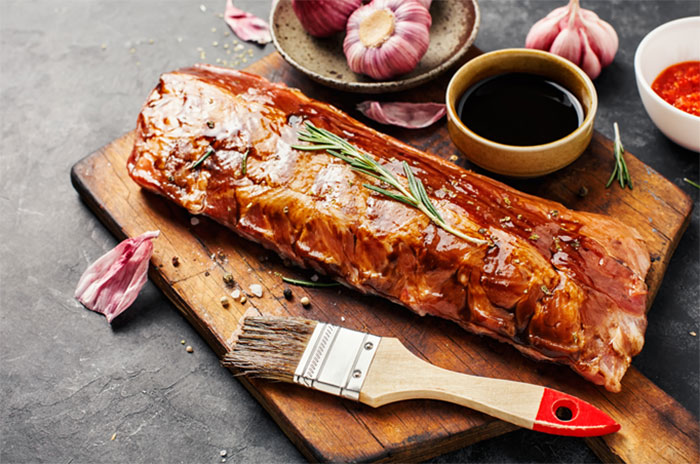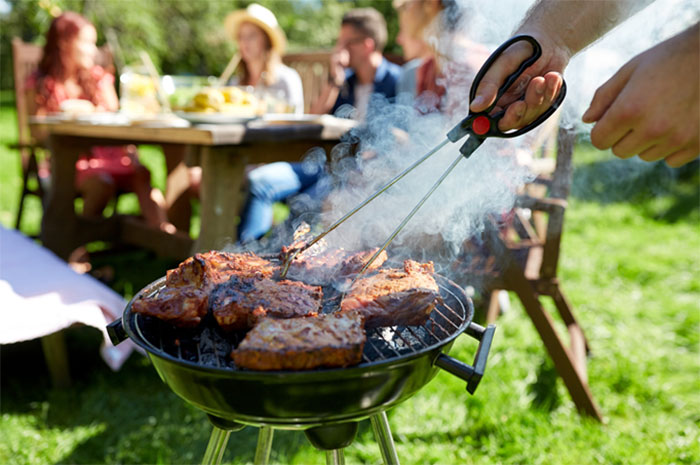
Grilling and barbecuing are not just about heating food over fire – it’s an art that requires practice and a good measure of skill. Whether you’re a budding grillmaster looking for new tips or simply a BBQ enthusiast seeking to hone your skills, this is the place for you!
The Art of Barbecuing and Grilling
In the world of outdoor cooking, nothing beats the smoky, savory allure of a perfectly grilled piece of meat or veggies. Mastering the grill opens a world of possibilities – from a simple BBQ chicken to the more complex smoked brisket. It involves controlling heat, managing flame flare-ups, and knowing when your food is perfectly done.
Importance of Mastering Grill Skills
Grill skills are like your secret weapon for outdoor cooking. There’s a big difference between just grilling and grilling well.- It boosts your confidence
– Elevates the flavors of your food
– Shows off your culinary competenceLet’s dive in and explore these 10 essential grill skills every barbecue enthusiast should master.
Understanding the Basics
To master the barbecue, you’ve first got to familiarize yourself with the basic grill skills. This starts with knowing the differences among types of grills and being savvy about essential accessories.
Different Types of Grills and Their Advantages
There are three principal types: charcoal, gas, and electric grills. Each brings its own flavor game to the table.
– A charcoal grill gives that authentic smoky flavor we all love in barbecue.
– Gas grills are convenient, easy to control, and great for quick BBQs.
– Electric grills cater to the environmental-conscious crowd, and they’re super easy to clean. Knowing what each offers helps determine the most suitable grill for your barbecuing goals and preferences.
Essential Grill Accessories Every Barbecue Enthusist Should Have
Next up is stocking up on much-needed accessories. Crucial tools include a grill brush for cleanliness, tongs for handling food, a meat thermometer for precision, and a sturdy spatula for flipping those succulent steaks. It’s also helpful to have a grill cover for protection against elements. And remember, good BBQ isn’t just about the main equipment–it’s as much about the accessories adding finesse to your grilling.
Knife Skills: The Foundation of Great Grilling
Before we dive headfirst into the delicious world of grilling, let’s first sharpen our knowledge on the important foundation: knife skills. Superior knife skills can vastly improve your grilling game.
Importance of knife skills in preparing meat and vegetables
Proper knife skills are crucial in ensuring your meat and vegetables are evenly cooked. Cutting consistently sized pieces guarantees a more uniform cooking time for every piece on your grill. It also elevates your presentation, making your delicious grilled dishes look as mouth-watering as they taste.
* Evenly cut pieces = Uniform cooking time
* Better presentation
Different knife cuts for different grilling techniques
Understanding the art of different knife cuts can drastically enhance your grilling results. Different grilling techniques call for specific cuts. For example, a thick slice is best for slow grilling while thin slices or dices are perfect for faster cooking methods.
* Thick slices for slow grilling
* Thin slices/dices for faster cookingWith your knife as your grill’s best friend, you’re already halfway up the barbecuing staircase! Up next, we’ll delve into the heat management of grilling.
Temperature Control: The Key to Perfect Grilling
One principal technique that sets the good griller apart from the casual weekend warrior is temperature control. Mastering this skill can turn you into a real grill artist.
The importance of preheating the grill
Just like your oven at home, preheating your grill is crucial to ensuring even cooking and perfect grill marks. Most experts recommend firing up your grill 15-20 minutes before throwing on your food. This step sanitizes the grill, helps food to cook evenly, and creates those tantalizing grill stripes that make our mouths water. Remember, patience preheats to perfection!
How to use direct and indirect heat for different types of food
Understanding when to use direct or indirect heat may seem complex, but it’s really quite simple:
– Use direct heat (putting food directly over the fire) for small, thin, or quick-cooking items like burgers, hot dogs, or vegetables.
– Indirect heat (placing food next to, but not directly over, the fire) is best for larger or tougher cuts that need to cook gradually, like roasts, ribs, or whole chickens.By mastering these temperature control techniques, you’re well on your way to grilling greatness. Stay tuned for the next grill skill!
The Art of Marination: Enhancing Flavor and Tenderness
Mastering the art of marination is an essential grill skill that can bring your BBQ game to the next level! It’s not just about slapping a concoction of sauces and spices onto your meat; there is a science behind marination that boosts the flavor and tenderness of your grill.
The Science Behind Marination
Marination works by breaking down the muscle fibers and connective tissue in meat, making it tender and saturated with flavors. The acid in the marinade, like vinegar or lemon juice, penetrates the surface and breaks down proteins, allowing the flavors to seep in. It also contributes to the Maillard reaction that gives your meat a beautiful, delicious browning on the grill.

Tips for Marinating Different Types of Meat
Each type of meat requires a slightly different marinating approach. Here’s a quick guide:- Beef: A hearty marinade with strong flavors like soy or Worcestershire sauce can stand up to rich beef. Marinate for at least 2 hours, but for optimal flavor, leave it overnight in the fridge.
– Chicken: A lighter, fruitier marinade often works well with chicken. Aim for a 2-4 hour marinade before grilling.
– Fish: Due to its delicate nature, fish only needs a quick 15-30 minutes in a mild marinade.
Mastering marination will lead to juicy, flavorful meats that will make your next BBQ a hit!
Grilling Techniques: Mastering the Flames
Let’s dive right into the heat of the matter. To make your BBQ a taste to remember, here are several grilling techniques you should definitely familiarize yourself with.
Direct grilling: Quick searing for smaller cuts of meat
This technique is perfect for smaller cuts of meat. Think about your sausages, kebabs, or well-marinated chicken fillets. The principle is to expose your food directly to the flame, allowing for a quick sear that locks in those juices, giving your meat a beautiful char and a tantalizing flavor.
– Preheat your grill on high heat.
– Toss your seasoned or marinated smaller cuts of meat.
– Sear each side for a few minutes for perfect barbecue.
Indirect grilling: Slow cooking for larger cuts of meat
Larger cuts of meat like turkey or a whole chicken demand a different, more patient approach. Indirect grilling is a slow cooking method that ensures your meat is entirely cooked through while remaining tender and moist on the inside.
– Preheat your grill, setting up a cooler zone away from direct flames.
– Place your meat on the cooler part of the grill, close the lid, and allow the magic to happen.
Smoking: Infusing smoky flavor to food
Want to bring out that irresistible smoky flavor in your food? Try smoking. This method again requires patience, but the reward is well worth it. You’ll need some quality hardwood chips or chunks to achieve that deep, smoky flavor.
– Preheat your grill to low heat, and use a smoke box or wrap your wood in foil, poking holes to allow smoke to escape.
– Place the wood on your heat source, and when the smoke appears, start your grilling session.
Perfecting Grill Marks: Presentation and Taste
Creating those aesthetic, Instagram-worthy grill marks on your food is not just about presenting fancy BBQ. It impacts the taste of food too. So how can mere stripes change the taste? Let’s find out below.
Tips for achieving professional-looking grill marks
Doing it like pros need certain grill skills. Follow these easy yet effective points:
– Preheat your grill on high for about 15 minutes to get a nice hot surface.
– Before placing your food on the grate, clean it with a grill brush to ensure it’s free from particles.
– Place your meat at a 45-degree angle for about 2-3 minutes, then rotate to create a crosshatch pattern. Remember, don’t move it around!
How grill marks affect the taste of food
Grill marks are the result of the Maillard reaction, a fancy term for a process where food is charred, giving it an irresistible, smoky flavor. It’s not mere decoration, it helps seal in all those lovely juicy flavors, providing a delightful, mouth-watering eating experience.
The Power of Seasoning: Elevating Flavors
One of the key grill skills that can transform your BBQ game is understanding the power of seasoning. Seasoning can add depth to every bite and elevate the natural flavors of the meat.
Importance of seasoning before grilling
Seasoning before grilling is like laying the foundation for a building. It prepares your meat and sets a flavor profile that will follow through to the last bite. You’ll want to salt your steaks, burgers, or chicken generously an hour before hitting the grill. This not only flavors your meat but also aids in achieving that coveted sear, giving you a juicier end product.
Exploring different seasoning options
While salt is the cornerstone of seasoning, there’s a whole world of flavor enhancers out there. Here’s a few you might consider:
– Pepper: Black, white, or cayenne, each brings a unique kick
– Herbs: Thyme, rosemary, and sage are great for beef and lamb
– Spices: Smoky paprika, cumin, or curry powder can add a nice twist
– Marinades: Turn to these for a more layered and complex flavorRemember, the goal of seasoning is to complement, not overshadow, the flavor of your BBQ. So don’t be shy, explore different combinations and see what works for you.

Food Safety: Grilling without Risks
Ah, the mouthwatering smell of grilling meats wafting through your backyard – it’s a true summertime delight! But remember, food safety is an absolute must to keep the good times flowing and the illness away. So, before your BBQ apron goes on, make sure you’re primed on crucial food safety practices.
Essential food safety practices for grilling
Firstly, it’s vital to keep your grill clean and free from grease buildup. Secondly, always ensure raw and cooked foods stay separate. Plus, remember to keep foods at a safe temperature. For instance:
- Never leave perishable foods, such as raw or cooked meats, at room temperature for more than an hour.
- Use a food thermometer to check the internal temperature of your meat. It’s the only reliable way to ensure thorough cooking.
Tips for preventing cross-contamination
Cross-contamination is a real party pooper, and you need to know how to prevent it. Here’s how:
- Have separate cutting boards and utensils for raw and cooked foods.
- Wash your hands thoroughly and often, especially before handling different types of foods. Knowing these simple but critical food safety spoils can make your barbeque a success – delicious, enjoyable, and safe for everyone.
Grilling Vegetables and Beyond: Beyond Meat
Now, let’s dive into one of the most under-appreciated aspects of barbecuing – grilling vegetables and beyond. Be it eggplant slices, asparagus spears, or even peaches, the grill infuses a unique smoky charm to their flavors.
Tips for grilling vegetables to perfection
Grilling vegetables can be tricky but rewarding. Here are some handy pointers to get them right:
* Cut the vegetables into similarly sized pieces for even cooking.
* Lightly oil them to prevent sticking to the grill.
* Cook high-moisture veggies like zucchini or peppers on medium to low heat to avoid burning.
* Flip veggies often to ensure a crispy outside and a perfectly cooked inside.
Exploring grilling fruits and other non-traditional foods
Beyond vegetables, there is an exhilarating world of fruity sweetness and irresistible charred marks waiting to be unveiled. Grilled fruits such as peaches, pineapples or pears are a delightful taste deviation. And for the veggie-burger lovers, let’s not forget the “Beyond Meat” patties that make a fabulous vegan grilling option. Don’t limit your BBQ adventures; explore the diversity and enjoy redefining your grilling escapades.
Perfecting Timing: When to Start and When to Finish
Grilling is more than just throwing a couple of steaks on a hot grate — it’s an art that requires patience, intuition, and above all, precision in timing. Understanding the ins and outs of perfect grill timing is a crucial skill to master for every BBQ enthusiast.
Understanding Cooking Time for Different Foods
Each food type has a unique grilling time, so it’s crucial to recognize these differences. – For example, chicken breasts usually require 6 to 8 minutes per side on medium heat.
– Thick burger patties might require about the same, while thinner ones could be ready in half the time.
– Tougher cuts of beef or pork ribs might even require a low and slow approach, taking several hours to reach tender perfection.
How to Tell When Food is Perfectly Cooked
Knowing when your food is done is another key aspect of grill timing. For meats, invest in a good quality thermometer to check internal temperatures. Remember that seafood should flake easily with a fork, vegetables should be tender-crisp, and burgers should be juicy, yet fully cooked through. Relying on sight, touch, and a bit of intuition will also get better with practice!

Mastering BBQ Sauces: The Finishing Touch
Grill skills extend beyond the initial sear, turning and timing over the grill. Perhaps one of the essential barbecuing techniques often overlooked is the use of BBQ sauces.
Importance of BBQ Sauces in Enhancing Flavors
BBQ sauce is not just an afterthought, but an essential ingredient that can elevate your grilling game. It accentuates the smoky flavors, makes your meats tender, juicy, and finger-lickin’ good. Whether applied prior, during, or at the end of grilling, it adds depth, a layer of flavor, and evokes a gratifying flavor profile that every BBQ lover craves.
Homemade BBQ Sauce Recipes for Different Taste Preferences
– Sweet and Smoky BBQ Sauce: This flavor-enhancing addition is perfect for those seeking a balance between sweet and smoky. Think brown sugar, ketchup, molasses, a touch of smoked paprika.
– Spicy BBQ Sauce: For those who like a kick, try pairing your grilled meats with a sauce that includes chili, garlic, and a dash of hot pepper sauce. Remember, a great BBQ sauce is just as essential as your grill skills in achieving barbecuing perfection!
Conclusion
Recap of the 10 Essential Grill Skills
In conclusion, let’s quickly go over the 10 grill skills that we’ve covered:
- Preheating your grill correctly.
- Understanding how to use direct and indirect heat.
- Maintaining a consistent temperature.
- Knowing when to flip your food.
- Mastering the art of marination.
- Experimenting with different flavors using wood chips.
- Getting the perfect grill marks.
- Recognizing when your meat is ready.
- Practicing safe grilling habits.
- Properly cleaning and maintaining your grill.
Encouragement to Continue Mastering and Exploring the Art of Grilling
Lastly, remember, becoming a grill master is a journey that requires passion, practice, and food-lovin’ spirit! The BBQ world has a bedazzling array of delicious recipes and techniques waiting to be discovered. So, wear your chef’s apron with pride because each grilling session is a new opportunity to make memorable meals while sharpening your barbecue skills. Enjoy the process, relish the results, and never stop fanning the flames of your grilling passion! Happy grilling my friends!





Leave a Reply